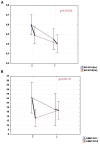Neurologic Music Therapy Training for Mobility and Stability Rehabilitation with Parkinson's Disease - A Pilot Study
- PMID: 26858628
- PMCID: PMC4726780
- DOI: 10.3389/fnhum.2015.00710
Neurologic Music Therapy Training for Mobility and Stability Rehabilitation with Parkinson's Disease - A Pilot Study
Abstract
Idiopathic Parkinson's Disease (PD) is a progressive condition with gait disturbance and balance disorder as the main symptoms. Previous research studies focused on the application of Rhythmic Auditory Stimulation (RAS) in PD gait rehabilitation. The key hypothesis of this pilot study, however, assumes the major role of the combination of all three Neurologic Music Therapy (NMT) sensorimotor techniques in improving spatio-temporal gait parameters, and postural stability in the course of PD. The 55 PD-diagnosed subjects invited to the study were divided into two groups: 30 in the experimental and 25 in the control group. Inclusion criteria included Hoehn and Yahr stages 2 or 3, the ability to walk independently without any aid and stable pharmacological treatment for the duration of the experiment. In order to evaluate the efficacy of the chosen therapy procedure the following measures were applied: Optoelectrical 3D Movement Analysis, System BTS Smart for gait, and Computerized Dynamic Posturography CQ Stab for stability and balance. All measures were conducted both before and after the therapy cycle. The subjects from the experimental group attended music therapy sessions four times a week for 4 weeks. Therapeutic Instrumental Music Performance (TIMP), Pattern Sensory Enhancement (PSE) and RAS were used in every 45-min session for practicing daily life activities, balance, pre-gait, and gait pattern. Percussion instruments, the metronome and rhythmic music were the basis for each session. The subjects from the control group were asked to stay active and perform daily life activities between the measures. The research showed that the combination of the three NMT sensorimotor techniques can be used to improve gait and other rhythmical activities in PD rehabilitation. The results demonstrated significant improvement in the majority of the spatiotemporal gait parameters in the experimental group in comparison to the control group. In the stability tests with eyes closed, substantial differences were revealed, indicating improvement of proprioception (the sense of body position and movement). These findings suggest a new compensatory strategy for movement and postural control through the use of the auditory system.
Keywords: Parkinson’s disease; gait; neurologic music therapy; stability.
Figures




References
-
- Aragon A., Kings J. (2010). Occupational Therapy for People with Parkinson’s. Best Practice Guidelines. London: College of Occupational Therapist.
LinkOut - more resources
Full Text Sources
Other Literature Sources
Medical
Research Materials
Miscellaneous

